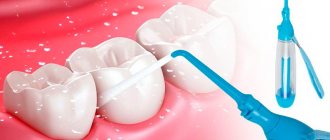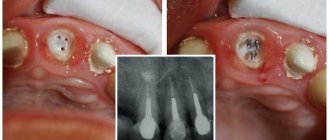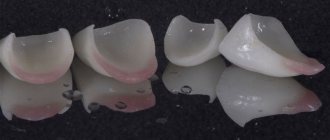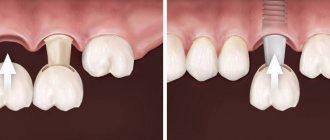Why implantation?
All methods of dental prosthetics prior to implantation negatively affect the condition of the oral cavity in the future, often causing premature wear and loss of teeth. In particular, the manufacture of bridge-like prostheses - bridges, as they are also called - requires the depulpation and preparation of two, and sometimes three, teeth to replace just one lost tooth.
Such radical treatment, to put it mildly, is not beneficial for the jaw system and leads to overload of the supporting units with further root inflammation and tooth loss. At the same time, the average service life of “bridges” is 6-7 years.
The situation with removable dentures is even more complicated: for any removable device, the support is the gums and bone tissue of the jaw, which, in principle, is not adapted to a full chewing load. As a result, a chronic inflammatory process develops, and the bone atrophies and dissolves.
Who can undergo implantation and who cannot?
Implants cannot be installed in girls under eighteen years of age, and in boys under twenty-one years of age, since during this period the bone is still forming, and implantation can disrupt this complex process. As for the upper age limit, there is no upper age limit for installing implants. Absolute contraindications include disorders of blood clotting and bone regeneration. It is prohibited to perform the operation on pregnant women and people with an unbalanced psyche. In all other cases, implantation is possible.
What to prepare for
Dental implantation is a technique that does not have the disadvantages of previous generations of prostheses. Implantologists consider it as the only way to restore lost teeth that does not harm the health of the oral cavity and has an unlimited (usually lifelong) service life.
Important! No other prosthetic method provides such high aesthetics as implantation.
But it should be taken into account that dental implantation is not a simple procedure during which an implant is simply inserted in place of the missing unit. The future tooth (more precisely, its root) must have a certain size, the proper position and direction, and a strictly defined inclination are selected for it.
In addition, it is necessary to restore all the tissue surrounding the tooth - and, first of all, bone tissue and gums. It is this comprehensive approach that allows us to achieve reliability, impeccable aesthetics, and durability of implant treatment.
Implantation is a slow process, except for one-stage implantation, as well as the “all on 4” and “all on 6” techniques. Treatment usually involves several stages, despite the common name of "two-stage" surgery.
Treatment always begins with diagnosis, which is the first and, perhaps, the most important stage that determines its outcome. Based on the results of the preliminary examination, a decision is made on implantation technology, types of implants, and the details of the upcoming operation are thought out.
Important! It is necessary to prepare for the fact that during the implantation process you will have to go through several stages. A standard scheme applies to all patients, so we have prepared a detailed description of each stage of dental implantation.
Stage 1: diagnosis
It may take some time to choose a clinic and an implantologist, since this is one of the key points in the whole story. In addition, you need to get to know the orthopedist and, if necessary, the therapist - these doctors will also take part in the process of implantological treatment. If everything is satisfactory, then before implantation an examination is carried out by a surgeon.
He will tell you whether it is possible in principle to place an implant in this patient, and will develop further treatment tactics based on the following data:
- general oral health;
- the presence and condition of neighboring teeth and gums, which are located next to the future implant root;
- bite;
- hygiene quality;
- financial capabilities of the patient.
The price is usually included in the total cost of treatment, which is carried out in most clinics on a turnkey basis. The doctor will announce the approximate cost, the final price is determined after diagnostic testing and consultation with an orthopedist. If a patient needs the help of a physician, hygienist or periodontist, then their services should be considered.
Diagnostics includes instrumental and laboratory studies, without which surgery is impossible. These examinations are necessary to exclude a number of complications after the introduction of implant rods and achieve extremely good treatment results.
Service life and how to care for implants
The service life of high-quality implants ranges from 10 to 25 years or for life. A low-quality implant may be rejected after 1-5 years, and it is not always possible to replace it.
It is not always possible to understand that a structure requires replacement. In some cases, the patient begins to be bothered by obvious symptoms - the gums rise or swell, and hurt. In others, the pathology is noticed by the doctor during an examination. Dentists recommend visiting a doctor annually for preventive purposes, even after restoration of the entire oral cavity.
Possible reasons for the end of the implant’s service life:
- injury;
- design rejection;
- peri-implantitis.
The service life of crowns depends on the material from which it is made. A plastic crown will last only 2-3 years, and a metal-ceramic crown will last 10-15 years.
To minimize the likelihood of complications, follow these recommendations:
- Be responsible when choosing a clinic and doctor. Sometimes it is better to overpay a little, but be confident in the high professionalism of the doctor. A common cause of construction failure is incorrect actions by the implantologist.
- Stop smoking. Cigarette smoke provokes mucosal irritation and inflammation, and damages crowns.
- Do not place excessive stress on the implant. Do not crack nuts with dentures or open bottles.
- Perform oral hygiene daily morning and evening, use dental floss throughout the day, and give preference to an electric toothbrush.
- Get an annual dental checkup and professional cleaning.
- Avoid facial injuries.
Following these rules will help you maintain a beautiful smile for many years.
Instrumental studies – tomography and x-ray
They are performed on all patients, regardless of the chosen implantation technology. Based on the data obtained, the issue of the types of implants and the methodology of the implantation operation itself will be decided.
An X-ray is taken selectively, precisely in the part of the jaw where implants are planned to be installed. Using it, the doctor evaluates the condition and location of the roots of the teeth, near which the implant should be installed. The price of such a photo starts from 700 rubles.
A panoramic photograph is needed for any type of prosthetics, and implantation is no exception. Otherwise, it is called an orthopantogram and is performed to take into account the characteristics of the bite and the condition of the bone tissue. All this is of great importance, since a strong foundation is extremely important for the implant root.
The price of a 3D image - orthopantogram - from 1500 rubles.
But the most important study at the diagnostic stage is CT - computed tomography. Without it, not a single dental implantation operation is performed, and neither an X-ray nor an orthopantogram can replace it.
Computed tomography is the most expensive examination at the diagnostic stage, the price of which starts from 3,000 rubles. Based on its results, the quality of bone tissue is assessed, the sites for installing implants and their type are selected. It is the tomogram that allows the implantologist to conclude that bone grafting is necessary if there is insufficient bone volume.
Modern medical centers where implantation operations are performed are equipped with high-precision equipment and use navigation programs. All this makes it possible to plan the course of treatment in detail and even show its future results to the patient!
Lab tests
The diagnostic stage before implantation necessarily includes a general and detailed blood test. This is a must for everyone. Certain categories of patients will need to provide the results of hormone tests (usually women) and other specific laboratory tests if there are concomitant pathologies.
A number of diseases are a relative contraindication for surgery to install implants, and then a preliminary consultation with a specialist is necessary. If necessary, before implantation, the condition is corrected to acceptable levels (for example, in the case of diabetes).
The price of sample collection services may vary and depends not only on the number of studies. Many tests are done in district clinics, and will be free if referred by a doctor. Thanks to this approach, diagnostic costs can be significantly reduced.
At the diagnostic stage, all patient data is collected, and based on the information obtained, the optimal method of dental implantation and type of implants are selected. After agreeing on the finished plan with the client, we begin to implement it. Next begins the stage of preparation for the implantation operation.
Contraindications to dental implantation
Unfortunately, it is not always possible to install implants. Contraindications to dental implantation include relative and absolute.
Absolute conditions include the presence of serious chronic diseases:
- diabetes mellitus,
- severe liver and kidney diseases,
- oncology,
- tuberculosis (in open form),
- immune diseases,
- cardiovascular,
- nervous diseases.
In addition, contraindications include childhood, allergic reactions to anesthetics, diseases that impair blood clotting, and bruxism (teeth grinding).
Relative (or temporary) contraindications include:
- pregnancy and breastfeeding,
- caries, inflammatory diseases of the oral cavity,
- malocclusion,
- smoking, alcoholism and drug addiction,
- infectious diseases,
- taking immunosuppressants.
At the same time, it should be noted that many diseases in remission allow implantation to be carried out by choosing the right technology and medications.
Stage 2: preparatory
Details of the preparatory stage may vary significantly for different patients due to differences in the condition of the oral cavity in general and the jaw bone tissue in particular. Most people planning to have implants require dental hygiene.
Sanitation is carried out with the aim of eliminating bacterial plaque from the surface of tooth enamel, since a successful implantation operation requires, if not sterility, then maximum cleanliness of the oral cavity. The presence of pathogenic microflora can provoke the development of inflammation, which should be avoided at any stage of implantation.
Hygienic cleaning is done using ultrasound when there is existing tartar, soft plaque is removed using Air Flow technology. The price of such reorganization is from 6,000 rubles.
At the preparatory stage before implantation, it may also be necessary to remove teeth, treat caries and periodontitis. The price of each procedure is calculated separately.
But the most serious step before installing implants may be bone grafting surgery. Very often it is impossible to do without it due to a lack of bone due to its resorption - resorption, natural loss. Bone volume can be greatly reduced if a tooth is lost or removed long ago, or due to individual characteristics.
As a rule, bone grafting is performed in the case of classical two-stage implantation, which places high demands on the quality of the jaw bone tissue. In addition, bone grafting is almost always necessary for patients who have lost teeth a year or more ago. During this period, the bone undergoes rarefaction and becomes brittle, which creates certain difficulties with fixation of implant roots.
There are several methods for performing bone grafting, or osteoplasty, using different materials. Therefore, the price will depend on the selected operation technology. There are 3 options in total:
- sinus lift;
- directed regeneration;
- autotransplantation.
Calculation of dental implants for implantation: how they fit in
For each specific case, the doctor determines the amount individually. It depends on the structural features of the oral cavity, the volume of soft tissues, and other indications. Please note that only a qualified specialist can correctly calculate the chewing load.
The general practice is to start with ten pins in each jaw if the patient is completely edentulous. If the installation position is correctly calculated, a good result can be obtained using six or eight support elements.
Installing many implants is expensive. Therefore, people with limited income strive to reduce their number. A properly made prosthesis will distribute the load evenly. But, in this matter, it is recommended to exercise healthy wisdom and choose the best option, based on the recommendations of a specialist.
The next question that is often asked in the dentist’s chair is: what material should the pin be made of? There are many elements used in this field, therefore, only a qualified specialist can determine the appropriate ones based on contraindications.
A competent doctor will offer several options to choose from that can solve the problem, so that the patient can independently choose the one that is suitable for the price.
Sinus lift
Sinus lift or subantral augmentation surgery before implantation can only be performed on the upper jaw. Its essence is to raise the lower septum of the maxillary sinus in order to increase the space of the alveolar ridge. The space thus freed is filled with bone tissue.
On a note! Sinus lifting is scientifically called subantral augmentation.
If there are no contraindications, the implantologist can combine sinus lifting with the installation of implants. Otherwise, the latter are placed in the jaw bone 3-6 months after the subantral augmentation surgery.
Sinus lifting can be open or closed, and its price depends on the chosen method. Open operations are estimated at the amount of 40,000 rubles, closed ones - from 20,000 rubles. It is important to know that this cost does not include the price of the bone material itself.
Complications during dental implantation
Implantation is a well-developed procedure over decades, studied in every detail, studied not only in the short-term consequences, but also in the long term. Therefore, with proper treatment planning and compliance with the entire dental implantation protocol, complications occur extremely rarely.
In most cases of complications or material rejection, the cause is violations of the surgical technology or a doctor’s error associated with a lack of experience, leading to the wrong choice of tools and equipment, violation of the rules of compliance with aseptic and antiseptic requirements, errors in preparatory procedures, implantation with insufficient bone tissue, injuries during surgery.
On the other hand, an error or negligence may be made by the patient, and complications may arise for this reason. For example, violation of restrictions on food intake (excessively hard or traumatic), alcohol consumption, physical exposure, failure to comply with hygiene or the requirements of antibacterial therapy, taking medications that reduce the effectiveness of treatment, etc.
Some complications may occur immediately after surgery, while others may occur after some time. Postoperative complications may include severe bleeding, sinusitis, or damage to the facial nerves.
If the patient has hypertension or cardiac pathology associated with rhythm disturbances (tachycardia), heavy bleeding may develop. Damage to the maxillary sinus due to unsuccessful implantation in the upper jaw can cause an inflammatory disease - sinusitis.
Due to direct damage, or pressure from the hematoma on nearby nerves, a disturbance in the transmission of nerve impulses may develop, a sign of which may be pain or persistent numbness of part of the jaw. More long-term consequences of implantation are peri-implantitis and rejection of the installed structure.
Peri-implantitis is an inflammation of the tissue around the implant, usually caused by an infection that entered the wound either with unsterile instruments, the material itself, particles of saliva during the operation, or later, through poorly placed or broken sutures. Other reasons may be the patient's failure to maintain proper hygiene or food intake after implantation, a violation of the treatment regimen, or injury.
With the development of inflammatory processes around the artificial root, new bone tissue and soft tissue around the implant cannot form (or are destroyed). The process is accompanied by pain, swelling, unpleasant putrid odor from the mouth, discharge of pus, as well as mobility of the installed implant, and even an increase in body temperature. This condition leads to the loss of an artificial structure - a tooth or denture.
This can happen a year after implantation. And if such signs appear, you should immediately consult a doctor. Treatment in these cases is always individual - it completely depends on the cause of the complications and the clinical picture. In some cases, it is necessary to remove the implant and install a new one in its place, in others, it is necessary to use other methods of prosthetics.
As already mentioned, the risk of such complications is extremely small - at the level of 2-3%. It can be minimized by choosing a qualified, experienced doctor who does not make mistakes, as well as by strict adherence to all his recommendations by the patient.
Autotransplantation (autologous transplantation)
Another type of bone grafting performed before implantation. It is essentially a self-transplant since the recipient is his own donor. A similar technique is used for extensive burns, when areas of the patient’s healthy skin are transferred to the burned areas.
A similar technology is widely used by implantologists. During surgery, bone blocks taken from the patient are implanted into the jaw bone. The recovery period after installing implants using autologous transplantation is quite long and can last up to six months.
Implantation of implant roots is possible after completion of osseointegration, after 6 months. The asking price is at least 50,000 rubles.
Stage 3: installation of implants
If bone grafting was performed, then the stage of dental implantation itself proceeds six months after the healing of the jaw tissue and successful integration of the bone. Surgical treatment for implantation of implant roots, in turn, is also divided into several stages, including:
- Stage 1 – pain relief. The type of anesthesia is planned at the diagnostic stage, and its choice depends on the scope of the intervention. When installing 1-2 titanium rods into the jaw, local anesthesia is usually given. If there are more, implantation may require general anesthesia or sedation;
- Stage 2 – incision of the gums and periosteum to gain access to the surgical field;
- Stage 3 – drilling a hole for the implant root in exact accordance with its dimensions and forming notches on the walls of the hole for better fixation of the future tooth in the jaw. The prepared hole is treated with an antiseptic, dried, after which the implantologist begins to screw in the implant itself;
- Stage 4 – installation of a plug to prevent tissue from growing inside the implant root;
- Stage 5 – suturing the gums and suturing. Implantation is complete.
On a note! Implant sedation is often chosen by patients who experience panic attacks before dental treatment. It is also indicated for people with heart disease and hypertension. Sedation is a safer alternative to general anesthesia, which is advisable to use for multiple dental implantations and bone grafting.
After the implants are installed, the patient is under the supervision of a doctor for some time, who at the same time instructs him regarding further treatment and care. If there are no signs of complications, after a couple of hours the person goes home, where he takes medications to speed up the healing of the gums and stimulate the osseointegration of the implant roots. In addition, he is given a leaflet with recommendations regarding oral hygiene after implantation.
The sutures after implantation are usually removed after a week, then a temporary crown can be installed. The price of the main stage largely depends on the type of implants.
Honestly about the disadvantages of implantation
Despite the significant advantages - restoration of the chewing load on the bone and stopping the atrophy of bone tissue, the feeling of the implant as if it were your own teeth, excellent appearance, durability and reliability, no need to grind down adjacent teeth - implantation also has its own disadvantages, which we will consider in detail.
1. Pain after implantation. Installation of an implant (or implant - everyone pronounces a foreign word differently) is a surgical operation with all the ensuing consequences - including pain for some time after the operation. During the normal course of the process, the pain goes away within a few (3-5) days.
2. Possible complications. One of the most serious complications is material rejection - the body does not perceive a foreign object and tries to get rid of it. Inflammation, pain, swelling, implant mobility, fluid secretion and even increased body temperature. To be fair, let’s say that the probability of such an outcome is very low - it is only 2-3% of the total number of people who have implants installed.
3. Presence of contraindications. Implantation, like most all medical procedures, has contraindications – situations in which it is impossible to install implants. These include: age under 20 years, diabetes mellitus (type 2), hepatitis, AIDS, other immune and cardiovascular diseases, bleeding disorders, bruxism and some others. Some of the contraindications can be circumvented, others cannot.
4. Long installation process. The installation itself can be carried out in literally 1-2 visits to the dentist, but the total period of engraftment of the artificial root can take from 6 months to 1-2 years. But in case of a favorable outcome (and this, we remind you, is 97-98% of all cases), you will have the same tooth as before, which will serve you without any problems for 10-20 years, or even more.
5. Caring for implants is more complicated than regular teeth, although not by much. They need to be cleaned more thoroughly, and you also need to regularly visit a dentist, who should monitor the condition of the implant and take timely measures if any problems suddenly arise.
6. The cost of implantation is very high. Prices for installing one implant start from 18,000 rubles - and this does not include the cost of the crown. In other clinics (especially in the capital), the total cost of a new tooth can exceed 100,000 rubles or more.
Still, the pros outweigh the cons in most cases. Otherwise, implantation would not be used so widely, and this technology, for a moment, is already more than 55 years old. The first operation was successfully performed by the developer of this technology and the founder of Nobel Biocare (which is still a leader in the scientific development and production of implants) Per-Ingvar Brånemark back in 1965.
Since then, millions of operations have been performed all over the world, several more large companies have appeared producing implants, instruments and components, implants of a more advanced form and from the latest, biocompatible materials have been proposed, the technology has been developed to perfection, and research into the consequences of implantation has become the most extensive nature, including many thousands of patients observed over decades. But still, let’s return to the disadvantages of implantation and analyze them more carefully.
Stage 4: rehabilitation after implant installation
The rehabilitation period is the time during which the implant root takes root in the patient’s own tissues. Only after osseointegration is completed can one proceed to the orthopedic stage and place permanent crowns.
It is impossible to shorten the healing time of implant roots, even if you take special calcium supplements and other medications. Depending on individual characteristics, it can average 3-6 months, although in most cases it takes at least six months.
The implantologist may recommend regular visits to the clinic to monitor the survival of the implant root (or roots). However, in the absence of discomfort and complications at the rehabilitation stage, the patient makes the next visit to the clinic at the very end. Next, a date is set for placing a gum former on the implant.
Stage 5: insertion of the healing abutment
This detail is necessary to give natural contours to the gums in the operated area. The former is screwed directly into the implant rod by cutting the soft tissue.
In essence, the plug is replaced, which is unscrewed, and a former is placed in its place in the implant channel. The manipulation is very simple and quite fast. An experienced implantologist performs it in a matter of minutes, maximum in half an hour, regardless of the type of implant. But an anesthetic injection is still given due to the incision of the mucous membrane.
This is where the main and most serious part of dental implantation ends, and after a week or two they move on to screwing in the abutment.
Step 6: Abutment Installation
The abutment is screwed directly into the implant root; it is the abutment that is the connecting link between the implant and the crown/prosthesis. The abutment is installed 2 weeks after the former and is selected individually for each client.
For example, when implanting teeth in the smile area and thin gum tissue, it is recommended to install zirconium abutments, since titanium “spare parts” can negatively affect aesthetics.
Placement of the abutment completes the implantation procedure and treatment continues with the prosthodontist.
Stage 7: prosthetics
After 1-2 weeks from the installation of the abutment, impressions of the teeth and jaws can be made. Crowns can be made from absolutely any material, but ceramic products are more suitable for front teeth. Implant roots in the area of chewing teeth are complemented by metal-ceramic or zirconium crowns.
The price of prosthetics varies depending on its type, since both crowns and removable, as well as conditionally removable dentures are placed on implants. In addition, the cost is affected by the material they are made of.
On a note! Zirconium is the most expensive, but also the most reliable material, which has high strength and excellent aesthetic qualities.
What is a dental implant
A dental implant is a metal structure in the form of a frame or pin that is implanted into the jaw, acting as a tooth root.
Subsequently, a permanent prosthesis is attached to the implant. An implant is necessary to secure a crown or bridges. Installing a pin does not require grinding of adjacent healthy teeth, and dentures fixed in this place will not slip or move. In addition, implants allow you to avoid atrophy of the gums and jaw muscles with age, as they imitate the root.
If we compare implants with other methods - removable dentures and crowns, then implants are much more convenient to use. The patient feels confident; there is no need to constantly remove dentures. Crowns secured to pins sit tighter and look beautiful. If you install crowns with bridges on incisors, the appearance will not be aesthetic.
Life after implantation
Once the implants have settled in and the crowns have been placed, it is important to properly care for them in order to maintain the results for as long as possible. The rules for caring for teeth with implant roots are standard, but with some peculiarities.
Firstly, you should use a brush with medium-hard bristles to avoid traumatizing the mucous membranes and ensure high-quality cleansing of new teeth. An implantologist or orthopedist will advise which paste is best to choose.
Secondly, it is advisable to rinse your mouth after every meal, but alcohol-based rinses are not suitable for this due to their ability to dry out the mucous membranes. A person with installed implants should have dental floss and an irrigator in their arsenal.
On a note! Insufficiently careful care of teeth on implants can shorten their service life and even lead to rejection.
One-stage, instantaneous implantation
Dental implantation of teeth can be not only two-stage, but also one-stage, one-step. If you choose one of these procedures, the installation of implants will take much less time, at least due to the absence of the need to build up bone before implantation.
In one stage, implantation is performed in two cases: with satisfactory bone condition and the use of special types of implants. During surgery, the implant is installed, and a temporary crown is immediately placed.
Unlike one-stage implantation, one-stage implantation involves the simultaneous removal of a tooth and the introduction of an implant into the same hole. But, like one-stage, one-stage implantation is performed with immediate loading, that is, after installing the implant, an abutment is immediately screwed onto it and a temporary prosthesis is placed.
Important! A temporary prosthesis on an implant can be replaced with a permanent structure after six months.
Classic one-stage implantation is also called non-surgical express implantation. It has a number of advantages, since the client:
- saves time - implants are installed in one visit to the doctor;
- saves money - the final cost of one-stage implantation is lower than classical two-stage implantation;
- obtains excellent aesthetics even in the absence of most teeth - and in the case of complete edentia, a dazzling smile can be achieved within 3 days;
- recovers quickly after installation of implants, and with a lower risk of infection, swelling and other complications, since simultaneous implantation is performed without an incision or stitches.
Thus, implantation in one visit to the dentist is the best solution, since it allows you to do without bone augmentation, which means saving time, money and preserving your own bone tissue in the area of the implant root.
Prosthetics on implants: reviews
You will be surprised, but most of the patients dissatisfied with implantation are not dissatisfied with the shape or color of the crowns, or the implant rejection that has occurred.
Almost 95% of all complaints relate to the unsatisfactory appearance of the gums around the neck of the implant (if we are talking about implantation in the area of teeth falling into the smile line). This is especially true for patients with a gummy type of smile. Of course, complaints about the poor aesthetics of the crowns themselves are also common (if the crown does not match the color and transparency of the surrounding teeth, standing out against their background). However, most often patients are dissatisfied with the appearance of the gums around the implant - the bluish color of the gums, the absence of gingival papillae, the occurrence of gum recession (i.e., a lowering of its level, resulting in exposure of the implant neck).
Most implantologists will try to screw in implants for you as quickly as possible so that you won’t run away anywhere. But only some implantologists know how to work with gum aesthetics. Therefore, if you are planning to implant your front teeth and have a gummy type of smile, it will be very difficult for you to find a suitable implantologist. Below we will give a couple of reasons that will inevitably cause gum problems after dentures.
- Thin gum biotype - to achieve good gum aesthetics, its thickness should ideally be at least 5 mm.
If your gum thickness is less (for example, 2-3 mm), then this means a 100% risk of poor aesthetics and the absence of gingival papillae around the implant. Even when planning implantation, the doctor must assess the thickness of the gums and plan an intervention that will forcefully increase its thickness. Such an intervention is, for example, transplanting a flap from the palate. It is most often carried out simultaneously with the installation of the implant, less often - after the end of the period of osseointegration of the implant. The meaning of the operation is that a small section of gum is taken from the palate (donor area) and sutured on the crest of the alveolar process - in the area of the installed implant. Unfortunately, such an operation quite seriously increases the cost of implantation.
- Lack of attached gums – gums around the teeth can be of 2 types: attached gums and mobile gums.
The attached gum is tightly fused to the periosteum and therefore does not move when the lips/cheeks move. The width of the attached gum around the implant should be at least 3-4 mm. If it is less, then over time the gums will detach from the implant - with the formation of a “gum pocket” and the development of peri-implantitis. As a result, there will be bluish, inflamed gum around the implant, and the inflammation will gradually lead to lowering of the gum level and exposure of the metal neck of the implant. Therefore, even when planning implantation, the doctor must assess the width of the attached gum and, if it is insufficient, perform a minor surgical intervention to increase it.











